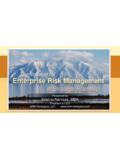Transcription of The application of risk assessment methods in making ...
1 Rev. sci. tech. Off. int. Epiz., 1991, 10 (1), 215-231 The application of risk assessment methods in making veterinary public health and animal health decisions HATHAWAY * Summary: The newly emerging discipline of quantitative risk assessment has wide application in the field of veterinary public health and animal health. Regulatory authorities are increasingly faced with public policy decisions that must assess the risks of new technology or practices relative to the potential benefits, thereby establishing a level of acceptable risk.
2 The elements of risk are a choice of action, a probability of loss and a magnitude of loss. Perceived risk and actual risk are seldom equivalent; adoption of the methodologies used in technological and human health risk assessments will allow veterinary regulators to make better decisions. Determination of levels of acceptable risk are increasingly dependent on quantitative models, and examples are presented for evaluation of different post-mortem meat inspection systems, estimating disease risks associated with animal embryo transfer and formulating national border protection strategies.
3 All models have some degree of subjectivity, and the decisions made by regulators and risk managers should incorporate a wide knowledge of the risk assessment process, as well as the conditions of use that will occur in the real world. KEYWORDS: Animal health - Border protection - Embryo transfer - Meat inspection - Risk - Risk assessment - Risk models - Surveillance - veterinary public health. INTRODUCTION Two major fields of veterinary endeavour are the health of economically important animals and the health of man (34).
4 The maintenance of efficient, progressive and internationally competitive animal production systems increasingly requires regulatory input in terms of evaluating new production technology. Maintaining the health status of domestic animals so that edible products are safe and wholesome is a major component; however, this objective is not always compatible with new technology that changes economics and enhances production. In addition, veterinary regulatory authorities have a major responsibility to ensure that meat inspection programmes for slaughtered animals provide specific standards of safety and wholesomeness.
5 Reassuring consumers with accurate and complete food safety information is emerging as an international priority (39). * Research and Development, MAF Quality Management, Ministry of Agriculture and Fisheries, Private Bag, Gisborne, New Zealand. 216 In meeting the above objectives, regulatory authorities must address the issue of risk. The newly emerging discipline of risk assessment provides a framework for consistent and orderly decision- making . Formal adoption of this methodology by the veterinary community is, however, in its infancy. RISK assessment Risk, meaning a danger or hazard, is an integral part of decision- making in the real world.
6 As the ability of an agricultural production system to alter its environment through technological change increases, the need better to quantify the risks inherent in the new technology increases. Decision- making involves a set of actions and outcomes and the characteristics of the associated risks are: a choice of action, a magnitude of loss and a chance of loss (40). Regulatory authorities are increasingly involved in decision- making processes which should assess the risks that may be introduced by new technology, relative to the potential benefits.
7 In addition, they should decide on what is a fair and acceptable risk to the promoters of the new technology, and to the people and the production systems that must bear the risk. The common goal is the reduction of risk, or the minimisation of loss/maximisation of gain (19). An agricultural system, whether viewed individually or nationally, is first and foremost a business. Druker (16) has summarised the business attitude to risk: "To try and eliminate risk in business enterprise is futile. Risk is inherent to the commitment of present resources to future expectations.
8 The attempt to eliminate risks , even the attempt to minimise only result in that greatest risk of all: rigidity." However, the ability to take risks implies a measure of control over the risk (19); regulating to control risk is meaningless unless the regulation is acceptable and achievable. There may also be conflict between technological estimates of risk and the public perception of the same risk. An "acceptable risk" is a decision problem: a choice is required between different courses of action. Willingness to take a risk is measured by the probabilities placed upon the alternative actions and the judgement as to the possible magnitude of the outcomes, which depends upon the environment in which the actions are taken (19, 33).
9 The risk assessment process is often multidisciplinary. Technological or engineering risk analysis will estimate the frequency and physical consequences of the undesired event which produces the risk. Health risk analysis will evaluate the human or animal health effects that may result from the physical consequences of the undesired event. An agricultural economist may concentrate on the characteristics of risk and choice under uncertainty, whereas a scientific researcher will primarily be concerned with quantifying risk. The final decision made by the policy-maker will reflect political and social needs as well as the risks (perceived and actual) that are characterised in the risk assessment process.
10 Defining risk Risk is the potential for realisation of unwanted negative consequences of an event; risk aversion is action taken to control risk (31). Construction of a decision tree presents decision choices as actions and outcomes. For each action the sum of 217 probabilities of the outcomes is unity. The probability distribution for a set of known outcomes may be agreed (risk); or it may not be agreed and have unknown outcomes (uncertainty). Reducing uncertainty in a system by gaining more information does not necessarily reduce risk. The elements of risk (19) are: - a choice of action (exposure to loss), either voluntary or involuntary; - a probability (frequency) of loss; - a magnitude of loss (character, extent and timing), assessments of which are not value-free.










